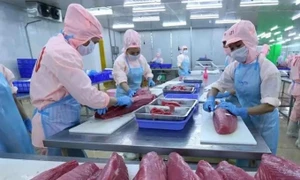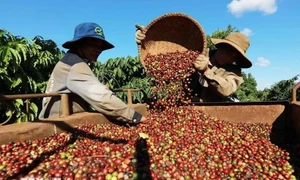
(VNS/VNA) - After the ‘rate war” in December when saving interest rates were pushed up to 11% per year at some banks, commercial banks started to adjust rates down after Tet (Lunar New Year) and cut further last week.
From February 9, National Citizen Joint Stock Bank (NCB) lowered its saving interest rates by between 0.2-0.45 percentage points, depending on the term. Both the six-month and 12-month term rates now stand at 9.3% per year, down from 9.7% and 9.5% per year, respectively.
Early last week, Sai Gon Commercial Joint Stock Bank (SCB) – the leading player in the ‘rate war’ last year – reduced saving rates on many terms. Its 24-month rate now stands at 9.1% per year, down from 9.95%, and the 12-month rate dropped to 9.5% from 9.95%.
Techcombank also cut saving rates by 0.5 percentage points for terms of six months or more from February 7, while PVComBank reduced rates by 0.2-0.3 percentage point, bringing the six-month rate down to 8.3% per year and 12-month rate to 8.8% per year.
Except the Big Four, including Agribank, Vietcombank, VietinBank and BIDV, which have kept their interest rates steady in the past several months, deposit rates listed at most banks now fall to 9.5% at the highest.
At the meeting between the State Bank of Vietnam (SBV), commercial banks and property developers on February 9, Vietcombank General Director Nguyen Thanh Tung said before this meeting, banks’ leaders agreed to cut the deposit rates to reduce the lending rate.
The ceiling deposit rate may be brought down to 8.7% per year in the coming time instead of the current 9.5% per year, a bank leader said.
The Governor of the central bank has asked commercial banks to continue decreasing operating costs, streamlining administrative procedures and unnecessary expenses to have room to reduce lending interest rates. The SBV emphasised that it will monitor cases where banks continue to raise interest rates and take measures to deal with these banks.
Unexpected but understandable
The banks’ movements, though surprised the market, are comprehensible given the context that many global central banks have officially slowed down their rate hike roadmap on belief that inflation has passed its peak.
In the policy meeting in early February, US Federal Reserve (Fed) only raised the key rate by 0.25 percentage points after having made four consecutive hikes of 0.75 percentage point in 2022 and one more 0.5 percentage point increase in the last month of 2022.
Meanwhile in Vietnam, some comments have suggested the pressure to continue raising the interest rate of the State Bank (SBV) to support the exchange rate in 2023 has decreased significantly.
In a recent report, Bao Viet Securities Co (BVSC) said deposit rates were almost flat in January, showing signs of cooling down from the fever in December and may continue to decrease in 2023 due to favourable macro conditions.
“BVSC believes that (SBV’s) pressure to raise interest rates to support the exchange rate will no longer continue in 2023. Instead, monetary policy this year is likely to shift to a supportive direction for growth,” it said in the report.
The securities company expects interest rates to fall again in 2023, with clearer signs from the second quarter, when the Fed stopped raising interest rates and Vietnam’s inflation cooled down.
According to Viet Dragon Securities Co, exchange rate pressure was the main cause for the hike of interest rates in 2022 but now this pressure has cooled down, which may lay a foundation for SBV to keep key interest rates unchanged in 2023.
In addition, the inflation target in 2023 is loosened to 4.5 % and fiscal policy shares the pressure with monetary policy, so the exchange rate is expected to decrease as well.
Challenges remain
However, pressure on interest rate is still large.
It can be seen that the lending rate now doubles or more of the deposit rate, averaging between 13-17% per year, even higher.
Economist Le Xuan Nghia, a member of the National Financial and Monetary Policy Advisory Council, said the current interest rate ground is too high.
If the inflation rate is around 4%, the savings interest rates should be around 6-7% per year to help keep the lending rates at rational levels.
Vietcombank Securities Company (VCBS) predicts the deposit interest rate will remain high at least until the middle of the year. Amid stiff competition to mobilise capital, VCBS believes the group of small- and medium-sized commercial banks will not reduce interest rates in major terms. It is forecast that deposit rates will peak in the first six months of 2023 with an increase of 1-1.5 percentage points.
Director of SBV’s Monetary Policy Department Pham Chi Quang said in 2023, the global economy is likely to have a recession, and at the same time Fed will continue its rate hike. These factors will put pressure on interest rates to continue.























